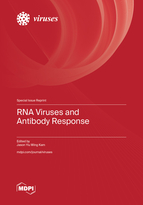RNA Viruses and Antibody Response
A special issue of Viruses (ISSN 1999-4915). This special issue belongs to the section "Viral Immunology, Vaccines, and Antivirals".
Deadline for manuscript submissions: closed (31 January 2023) | Viewed by 30610
Special Issue Editor
Interests: adaptive immune response; epitope identification; vaccine development; antiviral drug discovery; molecular diagnostics method development
Special Issues, Collections and Topics in MDPI journals
Special Issue Information
Dear Colleagues,
Infectious diseases represent a major, global-level public health concern. Clinically important RNA viruses (for example, Chikungunya virus (CHIKV), Dengue virus (DENV), Zika virus (ZIKV), influenza virus and SARS) garner increased attention due to the frequent emergence and re-emergence of pathogens. Epidemiological data show increasing evidence for the importance of antibody-mediated protection against RNA viruses, highlighting the possibility of using antibodies in therapeutic or prophylactic treatments. In this Special Issue, we focus on the adaptive immune response (particularly the antibody response) mediated by RNA virus infections. We invite research studies focusing on the evaluation of antibody responses, epitope identification, antibody-based diagnostic assays development, and vaccine developments. New investigative techniques or methods for the improvement of antibody profiles and the promotion of the health status of hosts are also within the scope of this Special Issue.
Dr. Jason Yiu Wing KAM
Guest Editor
Manuscript Submission Information
Manuscripts should be submitted online at www.mdpi.com by registering and logging in to this website. Once you are registered, click here to go to the submission form. Manuscripts can be submitted until the deadline. All submissions that pass pre-check are peer-reviewed. Accepted papers will be published continuously in the journal (as soon as accepted) and will be listed together on the special issue website. Research articles, review articles as well as short communications are invited. For planned papers, a title and short abstract (about 100 words) can be sent to the Editorial Office for announcement on this website.
Submitted manuscripts should not have been published previously, nor be under consideration for publication elsewhere (except conference proceedings papers). All manuscripts are thoroughly refereed through a single-blind peer-review process. A guide for authors and other relevant information for submission of manuscripts is available on the Instructions for Authors page. Viruses is an international peer-reviewed open access monthly journal published by MDPI.
Please visit the Instructions for Authors page before submitting a manuscript. The Article Processing Charge (APC) for publication in this open access journal is 2600 CHF (Swiss Francs). Submitted papers should be well formatted and use good English. Authors may use MDPI's English editing service prior to publication or during author revisions.
Keywords
- RNA viruses
- B cells
- antibody
- epitope
- vaccine
Related Special Issue
- RNA Viruses and Antibody Response, 2nd Edition in Viruses (9 articles)







